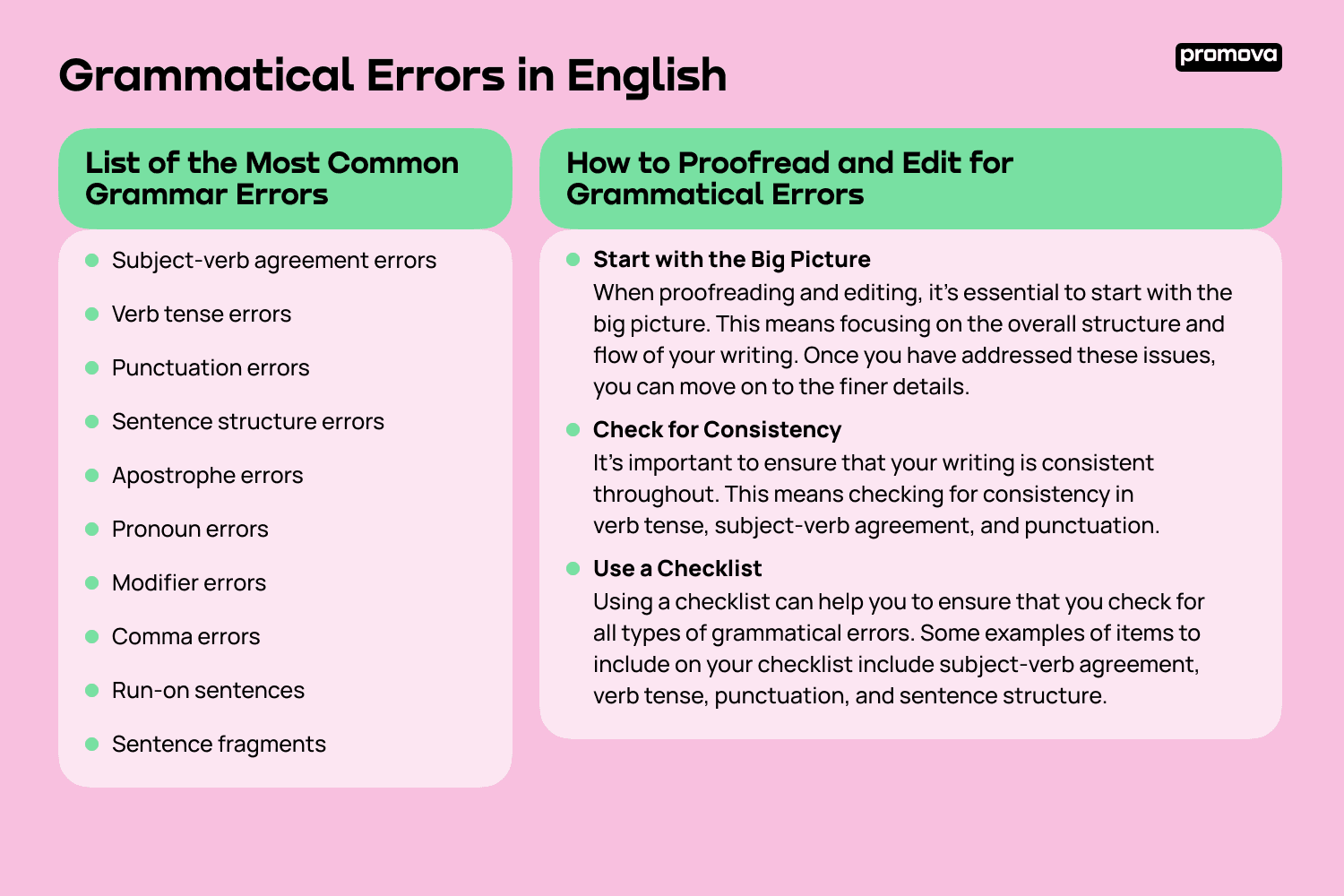Grammatical Errors in English
Contents
One of the most common types of mistakes that learners make is grammatical errors. Grammatical errors can make your writing difficult to understand and can affect your credibility as a writer. In this reference, we will explore what grammatical errors are, explore common types of grammatical errors, and learn to identify them.
What are Grammatical Errors?
Grammatical errors are mistakes made in the use of grammar in writing or speech. These mistakes can occur in various forms, including sentence structure, verb tense, subject-verb agreement, punctuation, and spelling.
Grammatical errors can make your writing challenging to understand and can detract from the overall quality of your writing.

Common Types of Grammatical Errors
There are several types of grammatical errors that writers make. The most common types of grammatical errors include subject-verb agreement, verb tense, punctuation, and sentence structure.
Subject-Verb Agreement
Subject-verb agreement refers to the agreement between the subject and the verb in a sentence. For example, “The cat runs” is a sentence with proper subject-verb agreement. However, “The cat run” is an example of a sentence with incorrect subject-verb agreement.
Verb Tense
Verb tense refers to the time frame in which an action occurs in a sentence. The three main verb tenses are: past, present, and future. It’s important to maintain consistency within a sentence or paragraph when using verb tenses. For example, “I walked to the store, and then I buy some milk” is a sentence with incorrect verb tense.
Punctuation
Punctuation is essential in writing as it helps to clarify meaning and create pauses and emphasis. Incorrect punctuation can lead to confusion and ambiguity in your writing. Common punctuation errors include missing commas, overuse of commas, and incorrect use of apostrophes.
Sentence Structure
Sentence structure refers to the arrangement of words and phrases to create a complete sentence. It’s important to ensure that your sentences are clear and concise. Common errors in sentence structure include run-on sentences, sentence fragments, and incorrect use of modifiers.
Examples of Grammatical Errors in Writing
Here are some examples of common grammatical errors in writing:
Example 1: Subject-Verb Agreement
Incorrect: The group of friends was arguing about where they are going.
Correct: The group of friends were arguing about where they are going.
Example 2: Verb Tense
Incorrect: He will go to the store yesterday.
Correct: He went to the store yesterday.
Example 3: Punctuation
Incorrect: I’m sorry I ate your sandwich, but it was delicious.
Correct: I’m sorry I ate your sandwich but it was delicious.
Example 4: Sentence Structure
Incorrect: Running through the park, the trees were beautiful.
Correct: Running through the park, I saw the beautiful trees.
How to Identify and Correct Grammatical Errors
Identifying grammatical errors in your writing can be challenging, but there are several ways you can identify and correct these errors. One of the most effective ways is by proofreading your work. Some tips on how to proofread:
Take a Break
It’s essential to give yourself time between writing and proofreading to ensure that you have a fresh perspective. Taking a break can help you to identify mistakes that you may not have noticed before.
Read Aloud
Reading your work aloud can help you to identify errors that you may have missed when reading silently. It can also help you to ensure that your sentences flow smoothly and are easy to understand.
Use a Checklist
Using a checklist can help you to ensure that you check for all types of grammatical errors. Some examples of items to include on your checklist include subject-verb agreement, verb tense, punctuation, and sentence structure.
Once you have identified the grammatical errors in your writing, the next step is to correct them.
Here are some tips on how to correct grammatical errors:
Use Grammar Tools
There are several grammar tools available online that can help you to identify and correct grammatical errors in your writing. Some popular grammar tools include Grammarly and Hemingway.
Use a Style Guide
A style guide can help you to ensure that your writing is consistent and follows a specific set of rules. Some popular style guides include APA, MLA, and Chicago.
Ask for Feedback
Asking for feedback from a friend or colleague can help you to identify errors that you may have missed. It can also help you to ensure that your writing is easy to understand and flows smoothly.
7
How to Proofread and Edit for Grammatical Errors
Proofreading and editing are essential in the writing process.
Start with the Big Picture
When proofreading and editing, it’s essential to start with the big picture. This means focusing on the overall structure and flow of your writing. Once you have addressed these issues, you can move on to the finer details.
Check for Consistency
It’s important to ensure that your writing is consistent throughout. This means checking for consistency in verb tense, subject-verb agreement, and punctuation.
Use a Checklist
Using a checklist can help you to ensure that you check for all types of grammatical errors. Some examples of items to include on your checklist include subject-verb agreement, verb tense, punctuation, and sentence structure.
List of the Most Common Grammar Errors
To help you avoid the most common grammatical errors, here is a list of the most common grammar errors:
- Subject-verb agreement errors
- Verb tense errors
- Punctuation errors
- Sentence structure errors
- Apostrophe errors
- Pronoun errors
- Modifier errors
- Comma errors
- Run-on sentences
- Sentence fragments
Summary
Grammatical errors are common mistakes that learners make while speaking or writing. These errors can make your writing difficult to understand and can affect other people's ability to understand you. Remember to proofread and edit your work carefully to make sure it's free of errors. If you follow tips and strategies outlined here, you should be prepared to create error-free texts and speeches. Good luck!
Comments